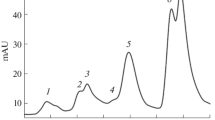Summary
Separation of hypocotyls and cotyledons of turnip seedlings (Brassica rapa) reduced the yield of anthocyanin from the former. Feeding with a combination of phenylalanine, acetate and glucose (PAG) considerably increased anthocyanin synthesis in these excised hypocotyls. In blue light the yield equalled that of the controls with cotyledons attached but, in far-red, the maximum obtained was never more than 55% of the controls.
A long pre-treatment with red light markedly reduced anthocyanin formation in far-red. In young seedlings (presumed to be still capable of de novo phytochrome synthesis) this effect could largely be overcome by feeding with the same phenylalanine-acetate-glucose medium used with isolated hypocotyls but, in older seedlings, feeding did not prevent the effect of pre-irradiation with red light. It is concluded that red light not only destroys phytochrome but also leads to substrate disappearance.
Without feeding pre-irradiation with red did not materially affect the yield from blue light; the addition of the phenylalanine-acetate-glucose mixture caused a significant increase compared with treatments without pre-red in both older and younger seedlings, particularly in the hypocotyl. The blue sensitive system thus appears to be independent of phytochrome destruction.
Feeding also increased yields in red light. In water 72 hours red was no more effective than 24 hours: with PAG the longer irradiation period resulted in a considerably increased yield, especially in younger seedlings. The low yields in red light thus appear to result partly from substrate deficiency.
Zusammenfassung
Durch Entfernung der Kotyledonen wird die Anthocyansynthese in den Hypokotylen von Rübenkeimlingen (Brassica rapa) stark herabgesetzt. Mit einem Stoffgemisch aus Phenylalanin, Acetat und Glucose (PAG) können solche isolierten Hypokotyle jedoch eine beträchtliche Menge Anthocyan synthetisieren. In Blaulicht wurden damit Werte in Höhe der Kontrollen (Kotyledonen nicht entfernt) erzielt, aber in Dunkelrot betrug das Maximum nie mehr als etwa 55% der Kontrollen.
Eine lange Vorbestrahlung mit Rot reduzierte die Anthocyanbildung in Dunkelrot. In jungen Keimlingen (die vermutlich noch zu einer Neusynthese von Phytochrom befähigt sind) konnte dieser Effekt weitgehend aufgehoben werden, wenn Phenylalanin, Glucose und Acetat zugesetzt wurden. In älteren Keimlingen gelang dies jedoch nicht mehr. Daraus wird geschlossen, daß Rotlicht nicht nur eine Destruktion von Phytochrom, sondern auch ein Verschwinden von Substrat bewirkt.
Bei in Wasser belassenen Keimlingen war eine Vorbestrahlung mit Rot praktisch ohne Einfluß auf die Anthocyansynthese in Blaulicht. Der Zusatz der Phenylalanin-Glucose-Acetat-Mischung bewirkte jedoch, besonders im Hypokotyl, einen signifikanten Anstieg des Anthocyangehaltes im Vergleich mit nicht vorbestrahlten Kontrollen, und zwar in jungen und älteren Keimlingen. Das Blau-sensitive System erscheint daher unabhängig von der Destruktion des Phytochroms zu sein. Auch in Rotlicht konnten die Erträge durch Stoffzufuhr gesteigert werden. In Wasser waren 72 Std Rot nicht wirksamer als 24 Std. Zusatz von PAG erhöhte aber den Effekt der langen Bestrahlungsdauer, besonders in jungen Keimlingen. Die niedrigen Erträge in Rotlicht scheinen daher teilweise aus einem Substratmangel zu resultieren.
Similar content being viewed by others
References
Butler, W. L., and H. W. Siegelman: Nonphotochemical transformations of phytochrome in vivo. Plant Physiol. 38, 514–519 (1963).
Evans, L. T., S. B. Hendricks, and H. A. Borthwick: The role of light in suppressing hypocotyl elongation in lettuce and Petunia. Planta (Berl.) 64, 201–218 (1965).
Furuya, M., and W. S. Hillman: Observations on spectrophotometrically assayable phytochrome in vivo in etiolated Pisum seedlings. Planta (Berl.) 63, 31–42 (1964).
Grill, R.: Photocontrol of anthocyanin formation in turnip seedlings. I. Demonstration of phytochrome action. Planta (Berl.) 66, 293–300 (1965).
—, and D. Vince: Anthocyanin formation in turnip seedlings (Brassica rapa L.): Evidence for two light steps in the biosynthetic pathway. Planta (Berl.) 63, 1–12 (1964).
——: Photocontrol of anthocyanin formation in turnip seedlings. II. The possible role of phytochrome in the response to prolonged irradiation with far-red or blue light. Planta (Berl.) 67, 122–135 (1965).
——: Photocontrol of anthocyanin formation in turnip seedlings. III. The photoreceptors involved in the responses to prolonged irradiation. Planta (Berl.) 70, 1–12 (1966).
Grisebach, H.: Die Biosynthese der Anthocyane. Proc. Intern. Congr. Biochem. 4th Congr. Vienna 2, 56–69 (1958).
—, u. L. Patschke: Zur Biogenese der Flavonoide, IV. Mitt. 2′.4.4′. 6′-Tetrahydroxy-Chalkon-2′-Glucosid-(β-14C) als Vorstufe für Quercetin und Cyanidin. Z. Naturforsch. 16b, 645–647 (1961).
Mohr, H., E. Wagner u. K. M. Hartmann: Zur Deutung der Hochenergiereaktion der Photomorphogenese (=HER) auf der Basis des Phytochromsystems. Naturwissenschaften 52, 209 (1965).
Price, L., K. Mitrakos, and W. H. Klein: Some kinetical aspects of light-induced carbohydrate utilization in etiolated leaf tissue. Physiol. Plantarum (Copenh.) 18, 540–549 (1965).
Siegelman, H. W., and S. B. Hendricks: Photocontrol of anthocyanin formation in turnip and red cabbage seedlings. Plant Physiol. 32, 393–398 (1957).
Vince, D.: Photomorphogenesis in plant stems. Biol. Rev. 39, 506–536 (1964).
Author information
Authors and Affiliations
Rights and permissions
About this article
Cite this article
Grill, R. Photocontrol of anthocyanin synthesis in turnip seedlings. Planta 76, 11–24 (1967). https://doi.org/10.1007/BF00387418
Received:
Issue Date:
DOI: https://doi.org/10.1007/BF00387418




